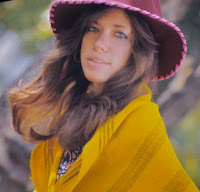"Being attractive sexually is not something which I feel guilty about or embarrassed by in any way", Carly told a Rolling Stone reporter soon after Playing Possum was released in 1975. The album cover and her defence of it represented a brave, although perhaps unintentional, intervention in that decade's earnest debates about sexual politics and the objectification of women in popular culture. Prior to Playing Possum, bands such as the Ohio Players and Roxy Music featured women in erotic poses on their album covers, but in that context - illustrating albums by all-male bands - eroticism could easily look exploitative or even degrading.
Carly's singer-songwriter contemporaries certainly took a more ascetic approach to album art. Has there ever been a frumpier album cover than Tapestry? Carole King is pictured knitting, and even her nearby cat looks bored by this predictable attempt at illustrating the album's title. Meanwhile, Joni Mitchell pursued her reputation as The Queen of Artistic Integrity by featuring her own paintings on her album covers. The cover of Playing Possum was startling in this context, and so too was Carly's insistence that it was fine for her to pose this way if it was her choice, her call and under her control.
Carly's singer-songwriter contemporaries certainly took a more ascetic approach to album art. Has there ever been a frumpier album cover than Tapestry? Carole King is pictured knitting, and even her nearby cat looks bored by this predictable attempt at illustrating the album's title. Meanwhile, Joni Mitchell pursued her reputation as The Queen of Artistic Integrity by featuring her own paintings on her album covers. The cover of Playing Possum was startling in this context, and so too was Carly's insistence that it was fine for her to pose this way if it was her choice, her call and under her control.
"I think it is the containment of emotion that is exciting about this particular picture", she said of the cover photograph, admitting that there were "much wilder" shots from her session with photographer Norman Seeff. You can see what she means. That clenched fist suggests she is holding back rather than giving all, and her dance to the edge of the studio backdrop also indicates a border that will not be passed. True, her hair is untamed, and the mind reels at the sight of those pursed lips, but this is an image of her own controlled abandon and strength. Her sexual expressiveness comes from within, and it serves as an extension of what she imagines beneath her closed eyes. There is not the slightest awareness of a viewer, and certainly no sense of pandering to a lascivious male gaze.
By all accounts, none of this was planned, and when the session began her skimpy black teddy was entirely covered. But with the wine flowing in Seeff's studio, and the sound system cranked up, Carly began dancing and lost herself in the moment. Later, when she and her manager, Arlyne Rothberg, looked across the contact sheet at a succession of the photos, they both landed on the cover shot: "that's it!". The shot fits with the album's title, at least insofar as it is playful, and it fits even better with the album's first single, "Attitude Dancing", which urges listeners to find their own groove (even if that means finding a new attitude).
 |
One could also say the cover suits an album that features so many songs about sex - or songs about "the body at play" as one critic delicately put it - but the songs on Playing Possum are exotically ("Look Me in the Eyes"), languorously ("More and More"), and at times broodingly ("After the Storm", "Slave") sensual. There are giddy ("Waterfall") and flirtatious ("Are You Ticklish") moments too, but anyone looking for the raunchiness suggested by the cover was likely to be disappointed, and in fact it probably hurt more than helped sales. Some stores refused to stock the album, while others would not display it.
To a world that had yet to encounter Madonna or Prince, the sight of Carly, in her black teddy and knee-high boots, strutting across an album cover, was positively avant garde in its frankness. After all, she was - famously - a married woman and a new mother as well. No wonder, then, that the back cover (below) featured a less powerful pose, and one that assured the viewer that a sense of humour and proportion were still very much intact.
In later years, Playing Possum would regularly featur in rankings of the best-ever album covers, and this makes it all the more maddening that when Elektra Records finally released the album on CD in the 1990s, the cover was so carelessly printed that the top of her head was cut off (see the image below). That is no way to treat a landmark album, and especially one that, initially at least, was greeted with as much dismay as appreciation.















